How to Cook for Vegetarians and Meat-Eaters (without making two separate meals!)
Are you a vegetarian, but the rest of your family eats meat? Or maybe you want to cook meat dishes, but one of your kids has decided to go veggie? Whatever your situation, there are plenty of ways that you can cook for vegetarians and meat-eaters at the same time – without having to make two entirely separate meals!
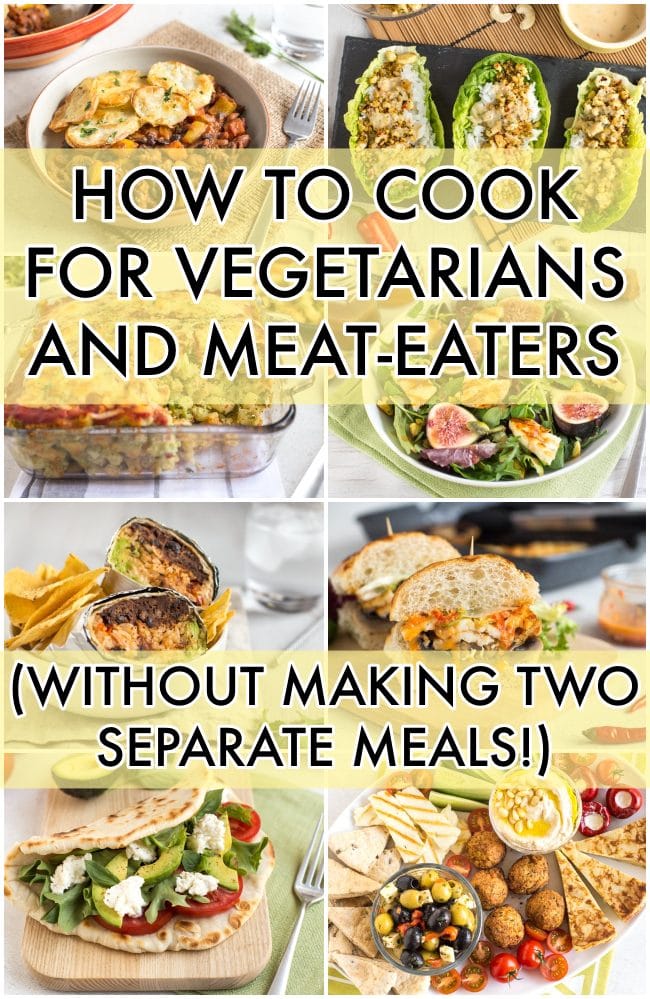
This is a question I get asked all the time: How can I cook for vegetarians and meat-eaters at the same time, without having to cook two entirely separate meals? People tell me they’re tired of having to cook something totally different for their partner or kids, as it means they spend twice as long in the kitchen, and produce twice as many dirty dishes.
Well, it doesn’t have to be that way! There are plenty of ways you can cook for everyone at once, without having to make two completely different meals.
This is something I have a lot of experience with – although my meat-eating husband is super supportive of my vegetarianism, and is happy to eat veggie 99% of the time, there have definitely been occasions where I’ve cooked something slightly different for the two of us. Plus, most of my family and friends are meat-eaters, and when we have people over for lunch I want everyone to feel at home. A lot of the time I’ll cook a vegetarian meal for everyone, but sometimes it’s just easier to accommodate everyone’s preferences.
I don’t enjoy cooking meat, and I’m certainly not endorsing meat-eating – in fact it felt weird writing this post and suggesting ways that my delicious vegetarian recipes could be adapted to include meat. I think it would ultimately be far better for the planet if everyone went veggie, or at least ate a lot more vegetarian meals. But on the other hand, I’ve never been a judgy or preachy vegetarian, and I appreciate that everyone has their own causes. If someone has decided that vegetarianism is not the right path for them, I respect that decision.
I also know that a lot of people struggle to give up eating meat because nobody else in their family is vegetarian, or they don’t allow their child to go veggie because they think it will immediately make their life harder – and if I can help someone to see that they won’t have to start cooking two separate meals every night, that can only be a good thing!
So let’s get to it.
When it comes to cooking for vegetarians and meat-eaters at the same time, there are a few different ways you can do it. They’re all good options, and the route you choose to go down will probably depend on what sort of meal you’re making. Here goes!
Option 1. Just change out the protein
How to do it:
Cook vegetarian side dishes, then just serve a different protein for the vegetarians and meat-eaters. You’ll all be eating 90% the same, so there won’t be too many additional pans to wash.
I know a lot of vegetarians aren’t fond of meat substitutes, but they’re really useful for this kind of meal. Veggie sausages, soya ‘chicken’ nuggets, grilled Quorn ‘steaks’ – they can all be used as one-for-one replacements for their meaty equivalents.
Meat protein ideas: chicken, fish, steak, that kind of thing (don’t ask me how to cook these as I’m not an expert…)
Vegetarian protein ideas: tofu, halloumi, meat substitutes – anything that can serve as a standalone protein item
Works well for:
– roast dinners
– burgers
– cooked breakfasts
– any meal where you have a carb, a vegetable and a protein as separate elements, e.g. bangers and mash!
– any protein where you can buy a vegetarian alternative, e.g. vegetarian ‘fish’ fingers with chips
Top tip:
If you’re baking one portion of meat and one portion of vegetarian protein (let’s say, a chicken breast and a piece of tofu), you can cook both on one baking tray (so only taking up one shelf in the oven!) by making a little ‘boat’ out of aluminium foil. Just fold up the edges of a piece of foil, and place the piece of meat inside. You can then place that on the baking tray alongside your veggie protein, and any meat juices will remain contained. Just make sure there are no holes in the foil!
Recipe ideas:
– ratatouille risotto (serve with grilled chicken or grilled halloumi)
– roasted feta and quinoa bowls (swap the feta for grilled chicken)
– very veggie mashed potato (serve with sausages or veggie sausages)
– halloumi and portobello mushroom burgers (cook beef burgers in the oven while you’re grilling the mushrooms) – pictured above
– vegetarian fishcakes (or regular fishcakes for the meat-eaters)
– vegetarian full English breakfast (swap the halloumi for sausages or bacon)
– low-carb cauliflower tabbouleh (serve with baked fish or falafel) – pictured below
Option 2. Serve some meat on top
How to do it:
Cook a vegetarian meal, and then scatter some kind of meat or fish on top for those who want it.
Remember, we vegetarians need to eat protein too! So you don’t want the meat scattered on top to be the only protein in the dish. You can either make a protein-rich dish in the first place (say, a bean-based soup), with the meat being an added extra for those who want it. Or, if the dish itself doesn’t have much protein, you can scatter a veggie protein on top for the vegetarians.
Meat protein ideas: tinned tuna, chunks of chicken breast, strips of steak, crumbled bacon
Vegetarian protein ideas: cooked beans (I use tinned), grated cheese, roasted chickpeas, crumbled feta, nuts or seeds
Works well for:
– salads
– soups
– simple pasta dishes
– any kind of dinner bowl
– stir fries
Top tip:
Tinned food is your friend! Rather than having to cook beans from scratch, and cook a piece of fish, try using tinned beans and a tin of tuna instead. Everyone can scatter as much as they like over their meal, and then you can save the rest in the fridge for the next day.
Recipe ideas:
– two bean and potato salad (add tinned tuna for meat-eaters)
– gnocchi primavera (add pieces of grilled chicken)
– slow cooker jalapeño and white bean soup (add crumbled bacon for meat-eaters – already plenty of protein for the veggies!) – pictured above
– creamy cashew and roasted red pepper pasta (add grilled chicken or a few extra nuts or seeds)
– fig and halloumi salad with balsamic fig dressing (add grilled chicken for meat-eaters) – pictured below
– warm brown rice salad with roasted aubergine and pistachios (scatter some ground lamb on top for the meat-eaters)
Option 3. Use two separate pans
How to do it:
It might sound like using two separate pans is the equivalent of making two separate meals, but it’s not! If you’re making a stew or casserole, you can make the exact same thing in two different pans, with barely any extra effort. Chop all your veg, and rather than dumping them into one pan, separate them into two. All the other ingredients can be added to both pans, with meat added to one, and some kind of veggie protein added to the other. Sure, you’ll have two pans to wash instead of one, but there’s otherwise the same amount of prep work and cooking time.
Meat protein ideas: beef, pork, lamb, chicken, mince (anything that can be cooked low and slow)
Vegetarian protein ideas: tinned beans, lentils, chickpeas, meat substitutes, paneer cheese
Works well for:
– curries
– soups
– stews
– casseroles
– spaghetti bolognese
– stir fries
– anything cooked on the hob!
Top tip:
Even if there’s only one vegetarian or one meat-eater in your family, it’s worth making a big batch of these kinds of meals. By the time you’ve started prepping, it’s not really any extra effort to make a larger amount. Stews and soups freeze really well, so you can freeze any leftovers in portions, to make for a quick and easy dinner another night.
Recipe ideas:
– tofu satay curry (use tofu in one pan and beef in the other)
– spicy bean hotpot with crispy potato topping (replace the beans with ground beef in one pan) – pictured above
– 15 minute creamy chickpea curry (use chicken instead of chickpeas in one of the pans)
– nutty tofu lettuce wraps with peanut sauce (use ground chicken instead of the crumbled tofu) – pictured below
– vegetarian Irish stew (use pork sausages instead of vegetarian sausages in one of the pans)
Option 4. Cook ‘build your own’ dinners
How to do it:
Prepare lots of different elements – some vegetarian, some not – and let people construct their own dinner. ‘Lots of different elements’ may sound labour-intensive, but it’s not – a lot of it can be raw ingredients that don’t even need any cooking (sliced tomatoes, that kind of thing). This works really well if everyone in the family has different tastes, as everyone can come up with a combination that works for them.
Meat protein ideas: cooked chicken, ham, cocktail sausages, strips of steak
Vegetarian protein ideas: grated cheese, vegetarian ham, vegetarian sausages, falafel, boiled eggs
Works well for:
– fajitas
– mezze-style dinners
– sandwiches
– salads
– baked potatoes
– dinner bowls
Top tip:
If you’re vegetarian and don’t want to have to cook meat every day, batch cook a few pieces at a time, and store them in the fridge (for about 3 days) or freezer (for a few months). Then you’ll always have something on hand to offer to the meat-eaters in your family. You can also buy pre-cooked meats, which can be good to keep in the fridge too.
Recipe ideas:
– homemade piada (Italian flatbreads) (with tomatoes, mozzarella, avocado, grilled chicken, salad, etc.) – pictured above
– easy mezze platter (served with hummus, falafel, cocktail sausages, anchovies, grilled chicken, etc.) – pictured top
– BBQ bean burritos (offer rice, beans, ground beef, lettuce, tomatoes, cheese, sour cream, etc.) – pictured below
– veggie fajita bowls (rice, salsa, veggies, halloumi, grilled chicken, etc.)
– breakfast muffins (refried beans, avocado, bacon, sausage, egg, sliced tomatoes, etc.)
Option 5. Cook a hearty omnivore-friendly vegetarian meal!
How to do it:
If the meat-eaters in your family are open to eating the occasional vegetarian meal, that’s obviously the option that’s going to involve the least amount of additional work. Just cook the same vegetarian dish for everyone, making sure to choose hearty dishes so nobody misses the meat.
Vegetarian protein ideas: beans, lentils, chickpeas, eggs, cheese
Works well for:
– pasta bakes
– curries
– stews
– casseroles
– pies
– anything that doesn’t traditionally contain meat anyway (e.g. tomato soup)
Top tip:
Be wary of offering any kind of meat substitute to meat-eaters, as I’m sure they don’t taste quite like the real thing. I do have lots of meat-eating friends who enjoy meat substitutes, so it can definitely work, but maybe just find out their opinion first! You don’t want to put a lifelong carnivore off all vegetarian food by offering them a faux steak that they don’t enjoy.
Recipe ideas:
– veggie enchilada stack
– mushroom stroganoff pie – pictured top
– creamy bean and spinach pasta bake – pictured above
– one pan chickpea curry and rice bake
– one pot vegetarian chilli and rice bake – pictured below
– slow cooker paneer tikka masala
– very veggie lentil bake
So there you have it! 5 different ways that you can cook for vegetarians and meat-eaters at the same time, without having to cook two entirely separate meals. I hope some of you find it useful, and perhaps it will even convince some people that they can give up meat without immediately making their lives 10 times harder!
And now I’m going to stop talking about meat…

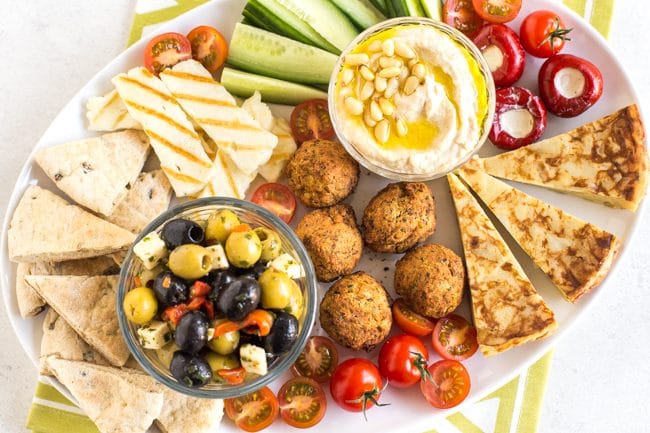
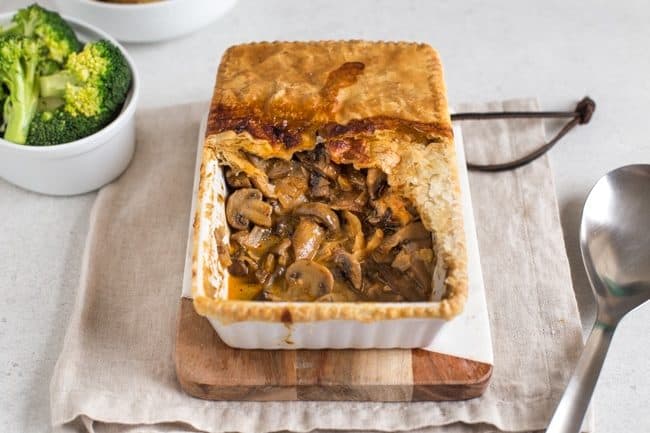

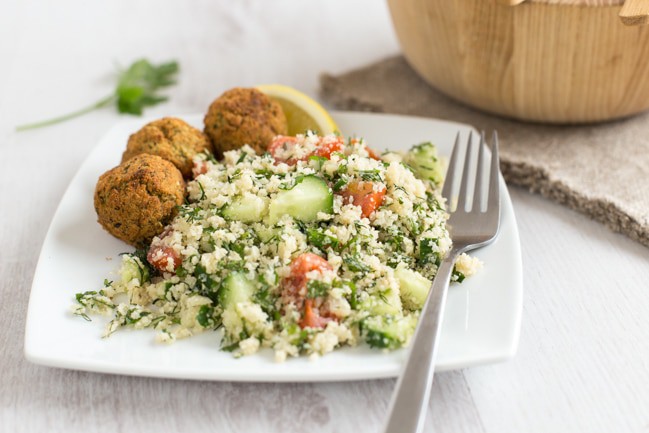
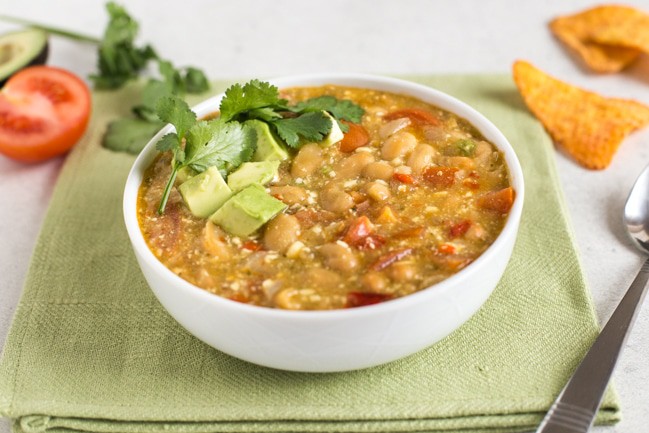
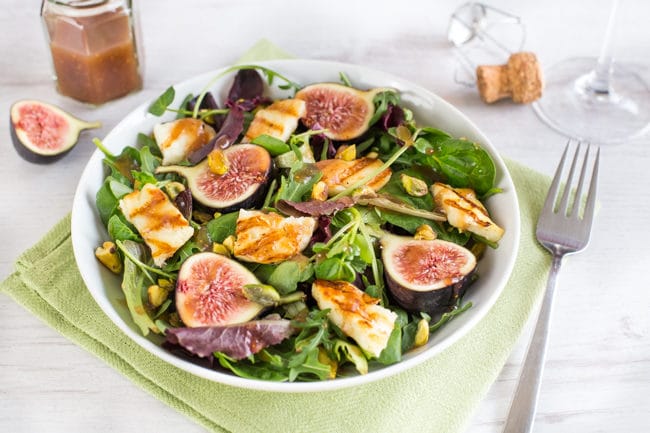
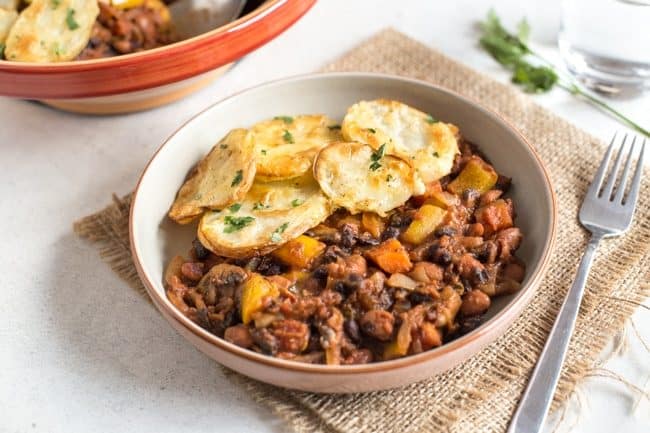
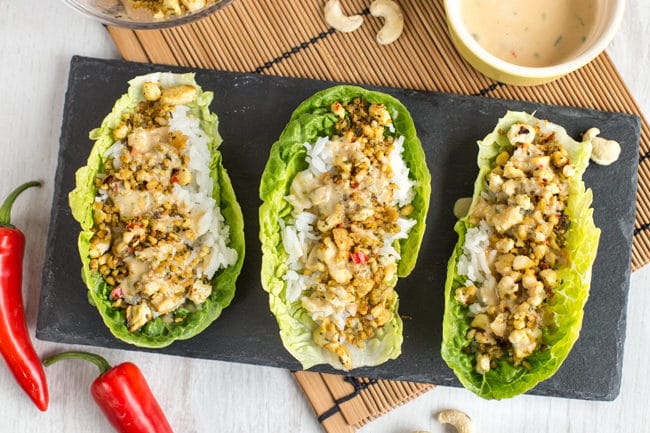
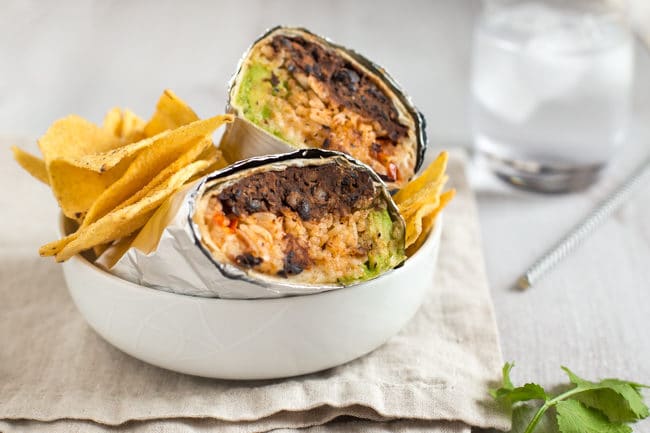
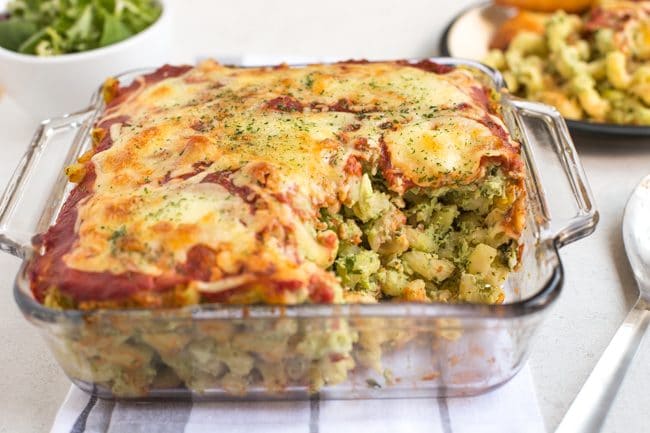
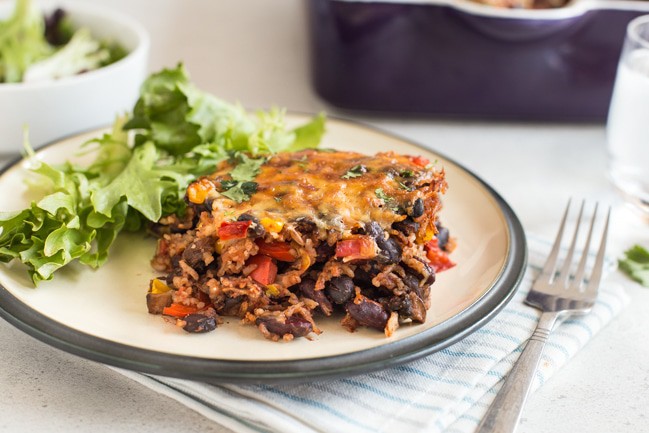
Thanks for this info. We are living overseas and want to eat less meat but I also don’t feel like I have the time or desire to learn a million new recipes, I like how your suggestions seem to fit in my wheel house.
Thanks
Ruth
Thanks Ruth, I’m glad you found this post helpful! Check out the recipes on the blog too, as they’re mostly super simple :)
Hi, im a 12 year old who is wanting to go pscaterian, what would you suggest?
Hi Syd! Important questions – what sorts of foods do you usually like to eat? There’s usually a way to make most things vegetarian-friendly, but it will depend on the sorts of things you usually eat. Don’t try to change everything in one go, as it probably won’t last. Second question – who does the cooking in your house, and are they supportive about you stopping eating meat? Are they willing to make small changes to accommodate you (assuming the rest of your family eats meat)?
You might like to check out this post for some more advice for new vegetarians – https://www.easycheesyvegetarian.com/11-tips-for-new-vegetarians/
This article was extremely helpful as I have recently gone vegetarian but husband is a die hard meat eater- thanks x
Thanks Lee, glad you found it useful! :)
This looks great for me ,my husband eats meat and I dont so find it hard to do meals for both .
I hope I’ve given you a bit of inspiration! :)
This is exactly the type of information I was looking for. Out house is two vegetarians, a vegan, and a meat lover. This is perfect – thank you. 🙂
Thanks Dianna! So glad I could inspire you :D